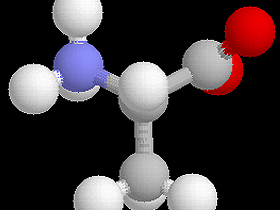 The disappearance of a single amino acid in the structure of proteins, or a change of place or the addition of one extra amino acid to the chain, will turn that protein into a functionless molecular mass. |
Amino acids are molecules, the building blocks of the proteins that make up living cells. More than 200 different amino acids are found in nature, but of these, only 20 kinds make up the protein in living creatures. Certain of these 20 amino acids combine with one another, forming a series of chemical bonds that create proteins with various functions and characteristics.
There are basic proteins, composed of about 50 amino acids, and other proteins are composed of thousands of amino acids. If a single amino acid is lacking in the structure of a protein—if it should alter its position, or if a single amino was added to the chain—that protein would be reduced to a useless series of molecules. For this reason, every amino acid must be in exactly the right place, in exactly the right order.
The theory of evolution claims that life came to be as a matter of chance—but it certainly cannot explain how this extraordinary order was formed by chance.
Although he’s an evolutionist, the American geologist William R. Stokes admits this fact in his book entitled, Essentials of Earth-History: “that it would not occur during billions of years on billions of planets each covered by a blanket of concentrated watery solution of the necessary amino acids.” 14
. . . no one has ever satisfactorily explained how the widely distributed ingredients linked up into proteins. Presumed conditions of primordial Earth would have driven the amino acids toward lonely isolation.15
Deliberate manipulations performed under laboratory conditions have not been able to produce the amino acids required to form a protein. Experiments done in this area have either been unsuccessful or, as with the Miller Experiment, employed invalid methods.
The Miller Experiment used substances that did not exist in the primitive atmosphere and created an environment that was not to be found in that atmosphere. What was created as a result were right-handed amino acids, which are not found in the structure of living proteins (See Miller Experiment, the.) Evolutionists still cannot explain how amino acids could have formed by chance, yet they persist in their claim that just the right acids, in the proper number and arrangements, somehow brought proteins into being. This is one of the greatest impasses faced by the theory of evolution. (See Protein.)
14 William R. Bird, The Origin of Species Revisited, Nashville: Thomas Nelson Co., 1991, p. 305.
15 Sarah Simpson, “Life’s First Scalding Steps,” Science News, 155(2), 9 January 1999, p. 25.


